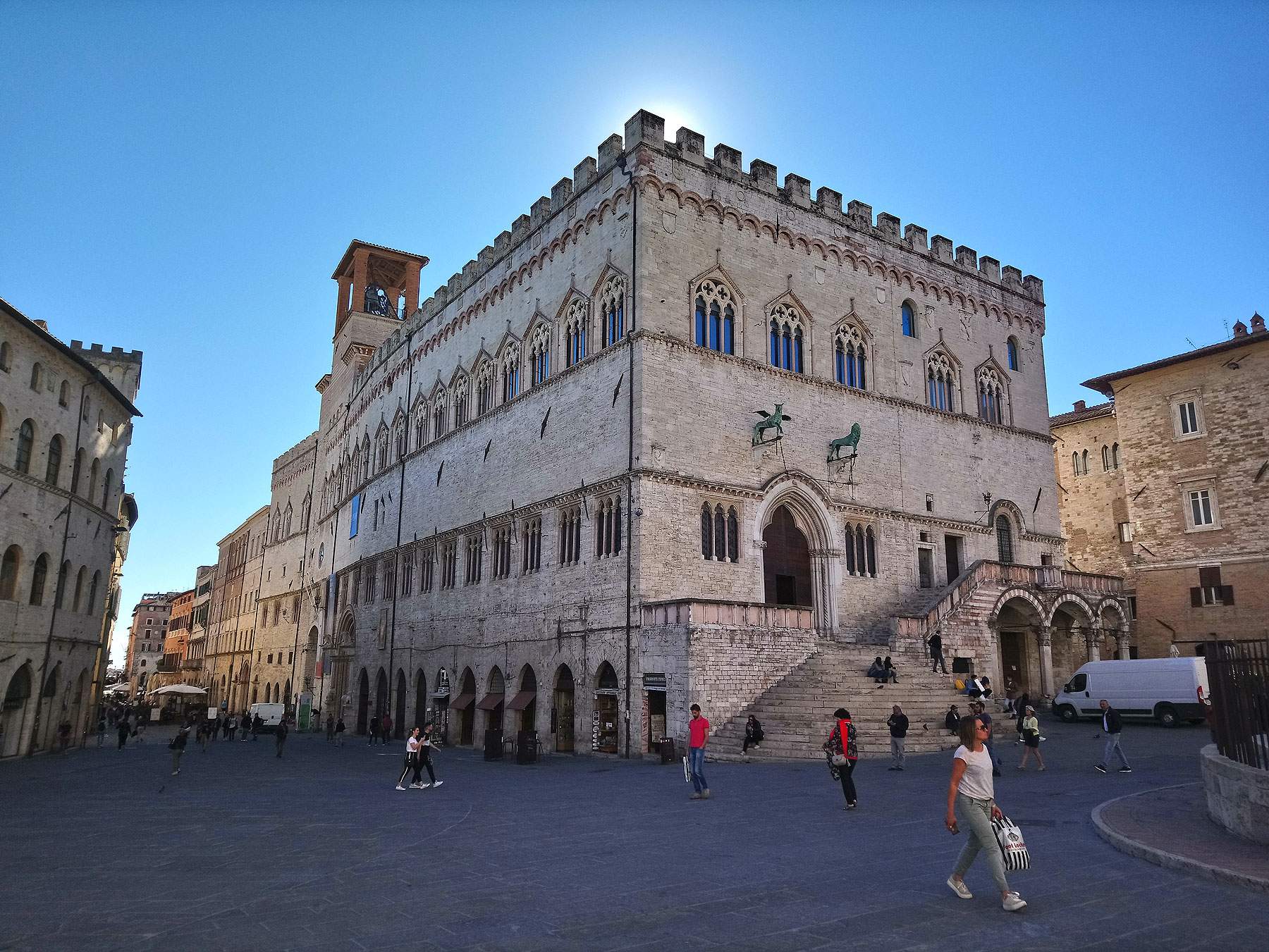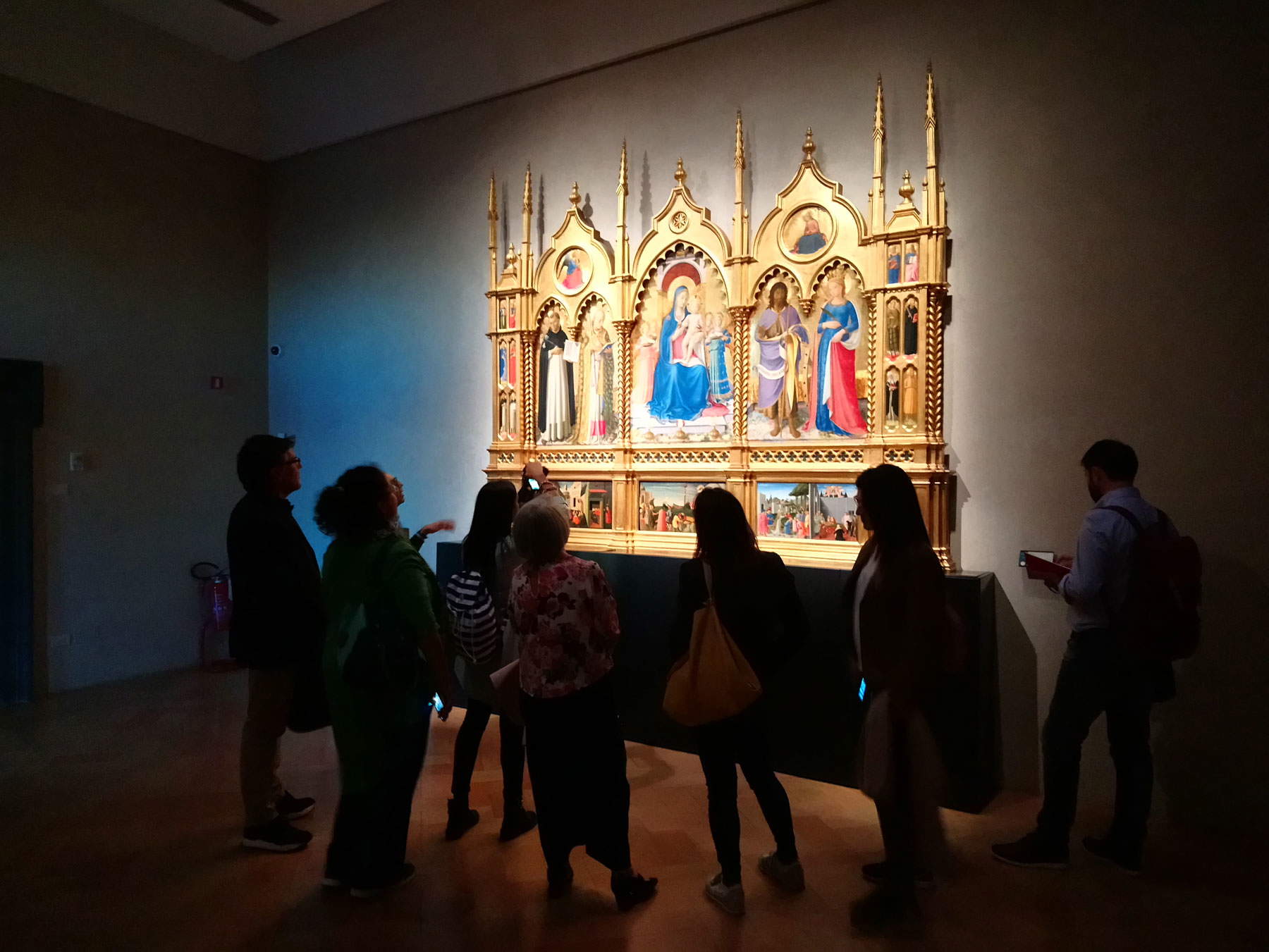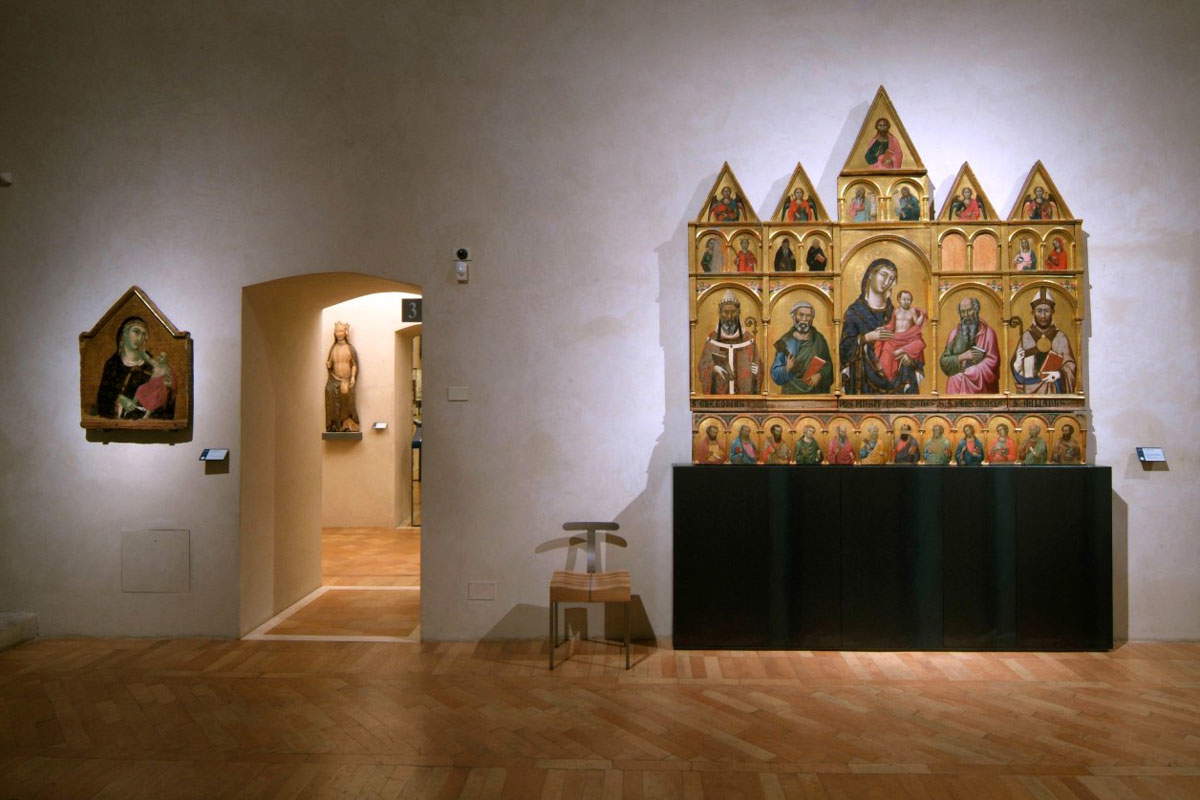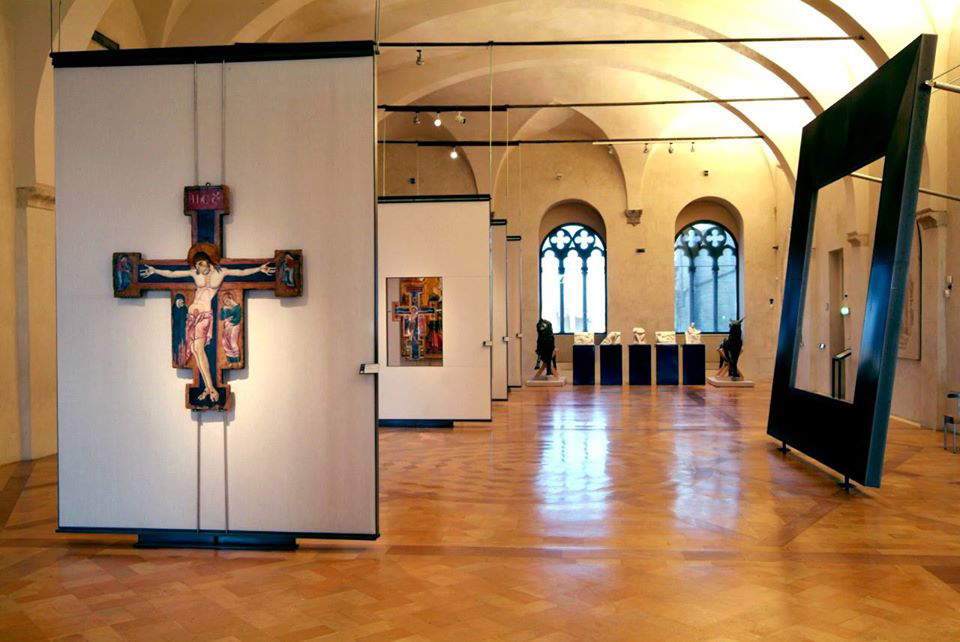In Perugia, the National Gallery of Umbria will close and reopen its doors in the spring of 2022 to allow for the Umbrian museum’s project to refurbish its exhibition itinerary. The last rearrangement of the National Gallery of Umbria, carried out in two phases between 2002 (third floor) and 2006 (second floor), configured its current face with outcomes certainly appreciable for elegance and consistency of solutions. Now, the rearrangement project, signed by Daria Ripa di Meana and Bruno Salvatici, worth 5 million euros and whose execution is entrusted to the Ganosis consortium of Benevento, has provided an opportunity to review the selection of the works and the criteria of their ordering along the exhibition route.
The intent pursued from the outset by the management was to work toward transforming the Gallery into a museum of the third millennium, faithful to its history and identity, but at the forefront in terms of heritage conservation, safety of goods and people, environmental sustainability, internal and external communication, interdisciplinarity and internationality of research. The rearrangement, which, as mentioned, will see the light of day in spring 2022, will offer visitors a simpler and more intuitive route, serving a chronological museum arrangement, with some inserts of works recently acquired or recalled from storage. Complementing the visit will be a multimedia project curated by Magister Art, designed for the purpose of providing insights and unprecedented angles on a selection of the heritage on display. The novelties will already begin in the atrium of Palazzo dei Priori with the new bookshop expanded in size as well as in function, and with new lighting that will enhance its architecture, vaults, ribs and ogive windows, all unmistakable evidence of the building’s medieval origin.
The new features do not end there. The work will create a restoration laboratory, a fully equipped teaching room and a library of art history, with more than 25,000 volumes, which will be possible to open to the public thanks to the help of Perugia City Council Mayor Andrea Romizi, who has granted the Gallery the use of the Hall of the Gryphon and the Lion and the room overlooking Piazza IV Novembre. The “green” aspect will not be overlooked either. The new, high-tech lighting system will be equipped with presence detectors that will allow the light intensity to be automatically calibrated; in the absence of visitors, the lights will be dimmed to a minimum, thus allowing significant energy savings. A restyling of the website and the launch of The Digital Gallery project, through which it will be possible to freely access all of the Gallery’s printed and photographic archival material, including that related to restorations, will complete the offerings.
 |
| Exterior of the museum. Photo by Finestre Sull’Arte |
Gallery, which holds mostly paintings of sacred subjects dating from the 13th to the 18th century. This type of collection is ill-suited to exhibition criteria that are not marked by the traditional chronological order, and it is in fact chronology that also marks the arrangement of the works in the new layout, with renewed rigor and with museographic solutions that introduce substantial novelties compared to the past. One of these is the decision to display artifacts of different techniques in dialogue with each other, eliminating distinctions related to material and giving an account of the richness of a collection that includes ivories, goldsmithing, medals, ceramics, ironwork and textiles. The ultimate goal is to encourage lanalysis of some fundamental passages in the history of art, which can be better understood by taking into account the interaction and mutual influence between different processes.
The exhibition will follow the common thread of the evolution of styles between the Middle Ages and the 20th century, with each room recounting a cross-section of it: the Giottesque revolution, the blossoming of Gothic in Siena, the brief but intense late Gothic season, and so on until a further, great novelty. For the first time, in fact, the National Gallery of Umbria opens to the contemporary, hosting works by the three most significant Umbrian artists of the 20th century: Gerardo Dottori, Alberto Burri and Leoncillo, international names but intimately linked to the region of origin. Among the main outcomes of the redesign is the creation of two monographic rooms dedicated to the greatest Umbrian master, Pietro di Cristoforo Vannucci, known as Perugino, whose works the museum preserves the largest number of, capable of representing his career from his beginnings to his death. These masterpieces, previously distributed in seven different rooms, are brought together in two large spaces, one on the third floor, dedicated to the youthful and early maturity enterprises, the other on the lower floor, destined for the most significant evidence of the last twenty years of his activity.
 |
| Museum Room. Photo by Finestre Sull’Arte |
One of the key aspects of the project for the new layout of the National Gallery ofUmbria is the conservation aspect, designed to facilitate the maintenance and control of the works and to respect the appropriate environmental conditions. Added to this is the desire to increase safety, through the design of earthquake-proof bases and the elaboration of a disaster plan. The museum collection consists mainly of panel paintings, which require special attention at the level of conservation and risk prevention. For the monitoring of thermo-hygrometric conditions, the number of sensors for detection has been optimized by providing dual wiring for network connection and power supply, which will ensure security and uninterrupted data recording. For the filtering of sunlight coming from the many large three-mullioned windows that characterize the Palazzo dei Priori and that it was decided not to screen (to maintain the dialogue of the interior spaces with the landscape and the city), special films will be placed for the elimination of UV (< 99%) and IR (< 97%) radiation, which are responsible for the photochemical degradation of some of the most delicate materials. Action will also be taken to reduce annual energy exposure (annual lux/h radiating the works) through the timing of the lighting system, based on detecting the presence of visitors inside the rooms with proximity sensors. Particulate air pollutants are another of the degradation factors to which the works are subjected, which is why continuous filament PVC mats capable of capturing dust effectively will be installed. Also for the control of pollutants, materials have been selected for the bases, showcases, coatings and paints, which do not release VOCs or substances that may interact with the construction materials of the work in addition to providing for the installation of appropriate sensors to detect the presence of volatile organic compounds and PM10. Particular attention was paid to the design of the bases and display supports of the works, for which lightweight yet durable materials (modular aluminum tubulars) were chosen, designed for each individual work. For those of greater weight and size, for which until now maintenance was particularly complex, given the possibility of intervening on the back, these structures were designed to be able to be moved away from the wall, while at the same time guaranteeing the necessary safety in the handling phase thanks to pantograph constraints. The modularity of the structures also allows the easy replacement of the works in case of loan or maintenance/restoration. It was then chosen to anchor the bases and showcases to the walls by means of semi-mobile hooks that will allow the asset not to suffer too much oscillation in case of a seismic event. For structures that cannot be anchored to the wall, earthquake-proof bases were designed responding to the new technologies implemented in this field. The new set-up was accompanied by an Emergency Plan of the works (disaster plan) that takes into account the new regulations on the subject and the guidelines dictated by theICCROM andICOM, accompanied also by indications on the disassembly of the works and a small manual of first aid to be put in place in case the work suffered damage. In the event of a disaster or emergency, for works included in the disaster plan, quick release systems will allow the work to be retrieved as quickly as possible. The National Gallery of Umbria will be one of the first state museums to have such an emergency plan.
On the seismic safety front, following an agreement signed in 2019 between the National Gallery ofUmbria and the Municipality of Perugia, an intervention is being finalized, financed by the Ministry of Culture and managed, as auxiliary contracting station, by the Municipality of Perugia, to reduce the seismic vulnerability of Palazzo dei Priori. To this end, geometric surveys, material investigations and seismic vulnerability checks of the entire building aggregate have been carried out preparatory to the design of the structural works that will complement the consolidation works already carried out on the palace following the 1997 earthquake, in line with the most recent regulations for the reduction of seismic risk to the cultural heritage. At present, the Municipality of Perugia is in the process of preparing an open call for tenders for the contracting of the design service for the seismic improvement works on the building complex.
 |
| Current layout. Photo National Gallery of Umbria |
According to the Gallery, the primary goal of communicating the new layout will be full legibility: redesigning spaces and routes also means pursuing certain strategic goals, such as full accessibility, physical and intellectual, and cohesive and coherent communication. The Gallery aspires to enhance that central role of narrator and, at the same time, spectator and actress in the qualification of the territory, its identity and history, in terms of education, social welfare and development. In order to concretize these vocations, the new layout (accompanied by a coherent cultural communication project) intends to re-evaluate the expectations of the public, to configure itself as a constant workshop, to combine a clear and precise exhibition itinerary with free individual paths.
Therefore, flows, i.e., movements (of people and things) through spaces, but also through time, will be taken into account in the design and redesign of the communication routes, and centers of interest and hypothetical bottlenecks (with consequent crowding and stops, taking into account barriers and height differences) will be evaluated. A new and original architectural-exhibit concept, while respecting the legibility of the container’s architecture, will allow the visitor to understand the stratification of the building, affected by the dynamic inclusion and exclusion: the continuous exchange between inside and outside, in fact, is an aesthetic peculiarity of the tour route, which will be enhanced as a narrative tool of the personality of the structure itself and its relationship, manifest and not, with the ancient. The new layouts, the museum points out, will have to address all audiences, providing specific and diversified levels of reading and interaction: all the most modern techniques of presentation, cultural and linguistic mediation, and scenography will have to be adopted in order to intercept the visitor’s attention and thus make the experience lasting and satisfying, as well as to offer opportunities for autonomy of vision and interpretation in a fruitful contemperance of guided suggestion and critical freedom. The possibility of choice and selection could, in fact, be a way to obviate boredom and distraction.
Since the museum is the princely place of recognition of identity, history and memory, the works will be presented in their singularity and in their valuable capacity to document and evoke artistic, productive and social complexes. In thisttica, the privileged museographic and aesthetic dimension will be polyphony, to be declined both in a paratactic discourse (relationship by which two or more elements connect with each other, while maintaining semantic and syntactic autonomy) and in a hypnotic perspective (hierarchical and subordination relationship that is established between two or more elements). Configuring itself, like all other museum institutions, as a form of nonverbal communication, the works and, in this case, ledificio become its words. It is for this reason that the written mediation, all drafted in augmentative and alternative communication, will have to enhance the reception and understanding of the primary message, coordinating with the museographic and exhibition concept, through limmagine rendered.
 |
| Current set-up. Photo National Gallery of Umbria |
Thanks to a new agreement with the City of Perugia, which has granted the National Gallery ofUmbria some rooms on the ground floor of the Palazzo dei Priori overlooking Piazza IV Novembre (the so-called Hall of the Gryphon and the Lion and adjoining rooms), the renovated museum will also include the new library. Inserting itself de facto into the already large circuit of public and private libraries in the city, the GNU will considerably expand its cultural role by offering a specialized contribution both in terms of book heritage and services; in the new library, in fact, resources and information referring mainly to the historical-artistic sector, restoration, conservation and protection of cultural heritage will be found. Conceived and furnished according to the most up-to-date standards at the end of a careful re-functionalization of the rooms and facilities designed by the internal staff, this new cultural space will be open to scholars, students and art lovers in order to ensure access and use of services also to disadvantaged or disabled citizens, towards whom the museum has long prepared library activities and museum itineraries specifically dedicated (Museum, space of memory, aimed at people with Alzheimer’s and Liberi d’Arte, aimed at the prison population of the Perugia area). Lattivazione of a reference service will also allow, in addition, to meet the needs, expectations and requirements of users.
With its bibliographic patrimony, endowed with over 25,000 volumes and pamphlets, constantly increasing thanks to donations, exchanges and purchases (Tax Credit Libraries 2020), the Library participates in the OPAC SBN project and is part of the Polo Bibliotecario Umbro (opac.umbriacultura.it), which allows it to guarantee accessibility to the catalogs also through the network. Finally, the added value of the Library is certainly its Historical Archives, one of the founding nuclei of the vast project of The Digital Gallery.
Since 2017, the project The Digital Gallery has been activated with the desire to make the cultural heritage usable and consultable also thanks to the digitization of all the physical consistencies present in the museum, from archival documents to historical photographs, passing through the texts inherent to the collection now out of print as well as inserting the multimedia objects related to the activities carried out in recent years. A need that is linked to the Gallery’s desire to promote and enhance its heritage by addressing the widest possible audience, so that the tour can begin even before the user is physically inside the museum’s rooms, thus allowing him or her to discover, learn about and explore the collection remotely as well. To date, more than 200,000 files have been digitized, making it possible to link each individual digital resource to the relevant artwork in the collection, so that a unique database can be consulted online. From the file of each individual work, it will then be possible to access a series of linked features, including thematic sections, enlargements of details, historical and inventory documents that have not been freely accessible until now, text descriptions and audio guides, links to additional pages, sharing buttons on major social networks and geolocation of the original provenance and current location in the Gallery. The enhancement and cultural enjoyment of the museum will thus radically change their form, to become a tailored experience in which the user will play an increasingly central role, having the opportunity to customize the cognitive exploration of the collection according to his or her interests. It will thus be possible to learn about and discover historical and conservation material that has hitherto been difficult to consult, thus also facilitating research by scholars.
In addition, in rethinking the website, in line with all aesthetic, museographic and communicative criteria, the Gallery will put the user exeperience at the center, through the importance attached to the end user. The site will be an open tool, liable to change based on user feedback. The criteria that inspired the restyling, after a phase of research and analysis, were the desire to understand what and how to communicate, including through a streamlining process aimed at full usability; the idea of building a tool in the optics of a walkable path, with varying degrees of focus; and the desire to use the website to find data on audiences, actual, potential and non-potential, and to organize targeting aimed at improving the museum narrative and cultural offerings. Within the new site there will be a general catalog of the works, which will be constantly updated on the basis of research and new studies; there will also be in-depth information on the works, on thematic itineraries (among which the highlight will be the musical one with audio pills in which the sound of the painted ones is reproduced thanks to ancient musical instruments), on the relationship with the territory and with the patrons, and a link for consulting the digital archive.
As for editorial activities, during the months when the museum’s refurbishment work will be carried out and access to the spaces will thus be barred to non-experts, the activities aimed at the Gallery’s public will focus toward parallel areas that would normally be ancillary to the visit but will now become central to ensuring interaction with users. Among these activities leditoria over the next few months will be one of the opportunities to keep alive the dialogue with the world of scholars and art lovers, giving an account even before the reopening of the many researches and studies on which the new order will be based. The list of these publications and their timing of release is very tight and will allow for the dissemination of a broad spectrum of scientific research topics, which were an essential premise for the design of the new arrangement of the permanent exhibition.
 |
| Perugia, National Gallery of Umbria closes for work: will reopen in spring 2022 |
Warning: the translation into English of the original Italian article was created using automatic tools. We undertake to review all articles, but we do not guarantee the total absence of inaccuracies in the translation due to the program. You can find the original by clicking on the ITA button. If you find any mistake,please contact us.